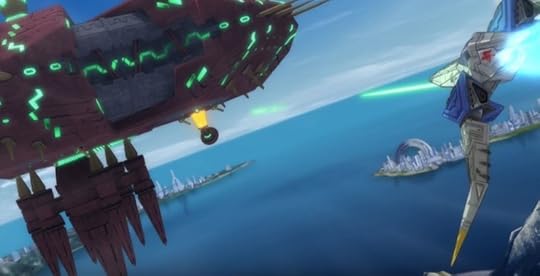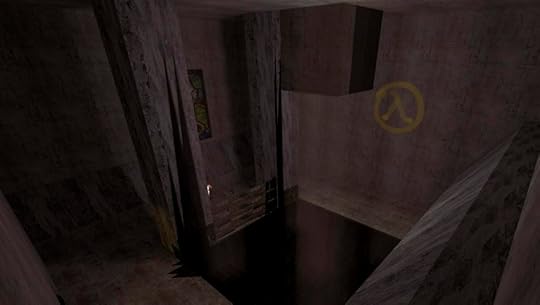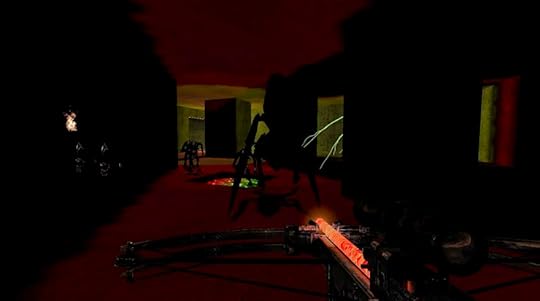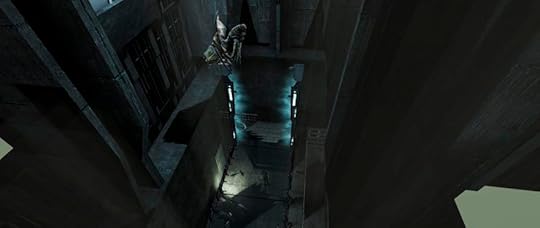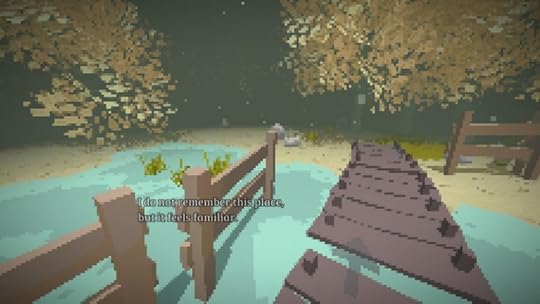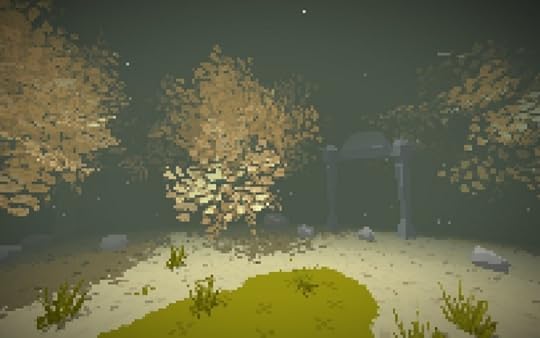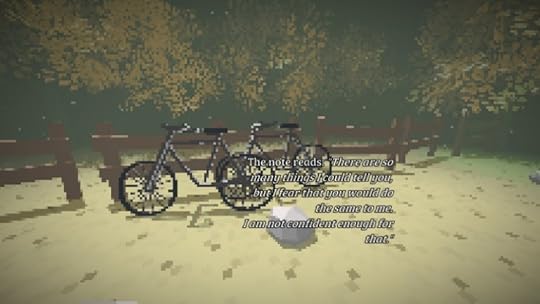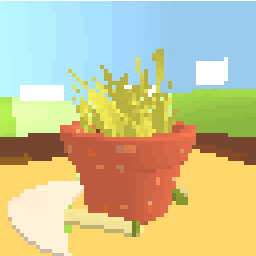Kill Screen Magazine's Blog, page 129
April 28, 2016
The joyless heroics of Star Fox Zero
As I sit at my keyboard, trying to figure out what in the world I could possibly say about Star Fox Zero, I find myself forced to concede that there’s not that much wrong with the game as a game. As an engine built to allow players to fly around in a high resolution version of a spaceship apparently built out of triangles, Star Fox Zero is entirely functional. There are things to blow up, which will also seek to blow the player up. There are big spaceships, and big imposing robots with hidden vulnerabilities (which are signaled to the player as glowing spheres on their bodies, kind of like in a Legend of Zelda game, but different, because they’re robots). But if, like me, you’re not already a Star Fox fan, I have a hard time imagining that Star Fox Zero will enamor you to the series. Right now, 23 years after the original game that birthed the series, the novelty of a cartoon fox as a starfighter pilot has long since worn off, and the conceit doesn’t serve any purpose in Star Fox Zero beyond franchise branding. And maybe it never did. There’s nothing particularly wrong with that, but there’s nothing especially right, either.
Star Fox Zero is a kids’ game for adults, and maybe even kids too, since there’s certainly nothing objectionable in terms of the game’s bloodless conflict. There is, after all, really no more in terms of story or character in Star Fox Zero than in, say, Microsoft Flight Simulator (1982). The prologue may state that an evil scientist named Andross is trying to take over the galaxy, but this is a lie. There is no Andross, there is no galaxy, and while we all know that the world is a fiction every time we sit down to play a videogame, Star Fox Zero barely bothers to maintain the pretense.
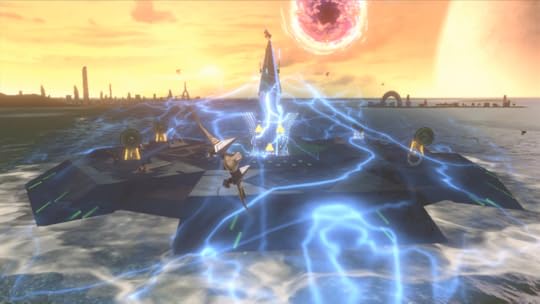
When the player takes control of the cartoon fox’s starfighter, Andross becomes the memory of a rumor, a name shouted at you in the past by a dog in a captain’s hat. Without a substantial framing narrative, every conflict in Star Fox Zero acts (or fails to act) as its own justification. There is no campaign, no theaters of war, no advances or retreats. Once, just once, does an emergency landing in one level result in a rescue mission in the next. For a player who enjoys games that at least pretend the player is doing things for a reason rather than just doing them for their own sake, this bit of subplot is like an oasis in a desert, but then the desert rolls on.
In another game, in another review, I might be talking about how this lack of connection between Star Fox Zero’s violence and the narrative universe in which the violence occurs could offer a compelling portrait of the distance in modern combat between the person (or anthropomorphic animal) tasked with pulling the trigger and the chain of command that decides when, where, and why the trigger should be pulled. Except that this isn’t what kind of game Star Fox Zero is. Star Fox Zero is a cartoon, a low(ish)-polygon combat flight simulator updated with more visual texture and new ways for the player to blow things up.
Unfortunately, if there’s little worthy of objection in Star Fox Zero, there also seems to be just as little that serves to engender joy. It might have been rewarding to treat Star Fox Zero as a game of objects, but when the design seems to be aiming for a sense of nostalgic clunkiness, there’s very little room to see any of it as particularly imaginative.
something sleek and edgy, but only the energy drink kind of edgy
The cartoon fox’s high resolution starfighter still wants to look as though it were made out of triangles, which ends up reading like a redesign by a focus group of middle managers. (“Make the ship look like the classic Arwing, only more awesome. You know, add some textures or something. Textures are a thing, right?”) On the other hand, the Arwing can transform into something akin to a walking chicken when the player needs to shoot things, which would be fantastic if not for my sneaking suspicion that the game was actually going for more of a dinosaur vibe. Something sleek and edgy, but only the energy drink kind of edgy.
Flying the Arwing is challenging but not rewarding. The divide between controlling navigation on the player’s main screen and directing weapons through motion control on the Wii U GamePad’s second screen is awkward at first, but far from insurmountable—it’s a system well suited for co-op play, and one that Splatoon (2015) players will find somewhat familiar. On the other hand, it happens more than once that the next step in defeating an enemy is unclear until the cartoon fox’s wingmen shout a strategy over the intercom. And while levels are relatively brief, being sent back to the beginning after every failure seems to operate as a penalty never quite made worthwhile through a sense of accomplishment or advancement.
The most interesting aspect of the game is discovering the different behaviors of each object in the world and creating a strategy for how to deal with them—a three-stage missile that opens up a new weak point and speeds up each time you destroy a stage—but this process tends to be frustratingly singular. There’s little that the objects in one stage have to do with objects in any later stage, which means that defeating any individual level acts more as a process of short-term memorization rather than learning. The end result is that successfully destroying an existential threat to life in the galaxy tends to feel about as rewarding as landing in a flight simulator. It feels good to have finally pulled it off, to have tweaked the airspeed and angle of descent just so, but it’s more of a relief than a joy.
If there’s something successfully old-fashioned about Star Fox Zero, it’s the way that playing the game can feel a bit like spending too long with Asteroids (1979) or Space Invaders (1978). At times it’s hard, and at other times it doesn’t feel quite as hard, but after a while when the “game over” screen pops up it’s almost welcome. Some players will keep coming back, and Star Fox Zero has at least a handful of rewards for those players—hidden pathways, secret objectives, digital tokens to be collected. But for a lot of players, these will feel like pushing to add a few extra points to their personal high score only without being asked to enter their initials after they’re done.
As a game, Star Fox Zero isn’t so much broken as deeply and disappointingly lacking in inspiration. Shiny but not smooth, it’s a game about a space-faring fox in a spaceship that turns into a chicken without any sense of joy, and that might be the biggest disappointment of all.
For more about Kill Screen’s ratings system and review policy, click here.
April 27, 2016
Teen ghost story Oxenfree to get new endings in upcoming Director’s Cut
Originally released for Windows, Mac, and Xbox One back in January, teen horror adventure game Oxenfree is now coming to the PlayStation 4 on May 31st as Oxenfree: Director’s Cut. It’ll come complete with a bevy of new features to find in its New Game+ mode, including new dialogue, new areas to explore, and new alternate endings to discover.
While the PS4 version will already have all of this content included at launch, Steam and Xbox One players need not worry, as they will also receive the New Game+ mode in an update on the same day. “Upon completing the story once, players are met at the start of a new game with fresh dialogue choices and a creeping sense of deja vu,” write Night School Studio, the creators of Oxenfree. “With this feature, players will be able to further change the supernatural events of Edwards Island and the spectres that inhabit it.”
The PS4 version will also see new features exclusive to its controller, where players can sync up the colors on their in-game radio with the colors on their controller’s light bar, as well as hear radio broadcasts through the controller’s speakers. “We set out to do something really special for the PS4 debut,” says Night School Studio co-founder Sean Krankel, hoping to please fans who have been waiting for the game to come to the console since its original release back in January. It’ll also have an exclusive console theme that displays scenes from Edwards Islands which change based on the time of day, if you’re into that sort of thing.
new dialogue, new areas to explore, and new alternate endings to discover
Perhaps the most exciting goodie for those interested in the nitty gritty of producing a videogame, players on all platforms will also receive a behind-the-scenes documentary detailing the creation of Oxenfree.
While downloadable updates are common in videogames, narrative adventure games tend not to employ them as often, preferring to move on once their stories have been told. With it’s new Director’s Cut, Oxenfree has an opportunity to expand and remix its world in a way that not only serves to keep the game fresh for old players, but also helps serve as an entry point for new players who might have missed the ferry to Edwards Island the first time around.
Oxenfree arrives for PS4 on May 31st. You can find out more about the game on its official website and follow the creators on Facebook, Twitter, and Instagram.
Visual novel has you experience the harrowing reality of social anxiety
I never lived in the dorms at my old university. But I have had my fair share of semi-unpleasant roommates. The scariest part of social anxiety, at least in my personal battle with it, is that it can stem from being thrust into a room with complete strangers, or even just being in the midst of any old acquaintance. In one particular apartment I lived in, a roommate of mine lived in a curtained-off living room. She was sensitive to noise, particularly if myself or the friend I shared a room with came home in the dead of the night after work or studying late. If I wanted to make food or grab a snack, I almost always opted to starve due to trying to avoid an awkward interaction with another person. That stress-inducing accidental human interaction is the premise of bite-sized interactive visual novel The Average Everyday Adventures of Samantha Browne.
The player is in Samantha’s thoughts, and share her anxieties
Samantha Browne is a short game, easily finished within 10 minutes, with multiple routes to take. You can play it safe, as I did, or you can lead Samantha down a path of even greater sadness and starvation. The game’s goal is simple: make oatmeal in the communal kitchen of Samantha’s dorm… except that it’s anything but simple. Samantha struggles with social anxiety. She worries that her flatmates will judge her, after an awkward run-in with a girl that judged her eyeliner abilities some time ago. Samantha doesn’t enjoy socializing, and would prefer to avoid human interaction entirely.
I relate a lot to Samantha. At the start of the game, she’s seen instant messaging with an internet friend, as she struggles to tell the truth about why she’s afraid to make oatmeal, or lie about the occurrence entirely. Much like Samantha, I also found solace in binge-watching television shows (in my case: anime), and hiding from the world behind a computer screen. Especially in college, where socializing is essentially all anyone around you does, it’s a harrowing reality to be too afraid to partake.
This is where Samantha Browne becomes a survival horror of sorts. As Samantha, you make pointed choices. The hallway is long, does Samantha rush to the kitchen, or return to her room to hide? The microwave is louder than expected, does Samantha deal with undercooked oatmeal, or suffer through the painful worry of a flatmate complaining? It’s these choices that make the player feel like they are Samantha. The player is in her thoughts, and share her anxieties.
In my playthrough of Samantha Browne, I was courageous. I made all the “right” choices. I was cautious when I felt caution was needed. I made sure my hunger meter never dropped too low, because that’s priority number one. I made all the right steps to get what I needed. I was playing as Samantha as I would never play as myself. Maybe others like me can learn from this sweet little game. The world isn’t actually as scary as it seems, and chances are, those girls chatting in the communal dining area don’t give a shit if you’re making noise while making oatmeal. In the meantime, it’s baby steps. And solitude is sometimes good.
The Average Everyday Adventures of Samantha Brown is available now on PC , Mac , and iOS for the low, low price of $0.00.
Upcoming game aims to give insight into growing up African American
Neil Jones and Daniel Wilkins are frustrated with the lack of diversity in videogames. They say it’s what has driven them to make their own game, and one that hopes to provide “a better insight into African American culture.” However, everyone they’ve approached for additional funding for it has told them to “focus on a ‘different type’ of character or story.” Which, yes, completely misses the point. Their game is called Clique, and both Jones and Wilkins, two-thirds of the Detroit, Michigan-based studio Dead Art Games, are determined to get it out to people. This is why they recently launched a Kickstarter.
Clique is described as a game that’s part top-down action adventure, part first-person adventure. In it, you play as two characters: Zhora, an African-American teenage girl, and the avatar character within the game she’s playing (also called “Clique”). Jones says Clique is about playing games to escape the real world, but it’s also how he intends to show people how he, and many other people who play games around him, grew up.
“That is how I feel at game conferences and most places outside of Detroit”
To that end, while the game within the game will feature elements and mechanics players are familiar with—completing tasks for NPCs, a turn-based battle system, puzzles, and boss fights—Clique will intentionally make people feel uncomfortable and unwelcome during certain segments. For example, many of the NPCs will be very cold to the player at first, but that can change if the right conditions are met. “That is how I feel at game conferences and most places outside of Detroit,” says Jones. “Hopefully [people that play the game] take some understanding out of that and have a new perspective [on] how others can feel.”
The music in Clique is another important component in representing African American culture. It takes inspirations from Supergiant Games’s Transistor (2014) and the Legend of Zelda series, and combines that with hip-hop, resulting in a genre Dead Art Games calls “Orchestral Urban Hip-Hop.” The hope is that the music will lay the groundwork for the “emotional atmosphere” present in each world. “That was all [sound designer Daniel Wilkins],” says Jones, explaining the choice of music. “Hip-Hop is a part of our culture and we want this game to represent us and our culture as best as we can.” You can hear a couple of tracks from the game on Wilkins’s SoundCloud page.
Jones is upfront about the kind of game he’s making, and the message he wants to get across to those who play it. He has several years of experience with game and app development, and he and Wilkins (who is a self-taught sound designer) have a genuine love for making games. “All [Wilkins] and I ever wanted to do with our lives was to make games,” Jones says “[We’re] really good at it, but the games industry rarely hires people of color and almost never makes a black person the main character of a game. So this game, this studio, the art, the music, it’s us trying to find our place in an industry that never wanted us.”
The Kickstarter campaign for Clique is seeking $35,000 in total before it ends in early May. Jones says that everyone on the team in confident in their game, as well as the campaign’s success, but backup plans have been made in the event that crowdfunding doesn’t work out.
Should Clique be ready for release in July as planned, it will arrive on Windows, Mac and Linux (Steam and DRM-free) first, with plans already made to eventually bring the game to the PS4, PS Vita, and Xbox One.
The search for a game to unite all esports fans
This article is part of a collaboration with iQ by Intel .
The genre-bending competitive games releasing in the next year have the potential to bring the usually divided fan bases of esports together. Many see esports as the next $1 billion sport, but getting there depends on a savvy intertwining of new titles and their diverse fan bases. If new gaming titles such as Blizzard’s Overwatch, Gearbox’s Battleborn and Epic Games’ Paragon are going to succeed as esports, industry insiders believe these titles have to evolve beyond popularity.
“There is sort of a secret sauce when it comes to esports,” said Marcus Graham, Twitch’s director of Programming. Enthusiasm for game titles is no longer enough to achieve esports stardom. Graham said games have to be fun to play but also fun to watch. They must create powerfully entertaining drama at all levels of competition.
games have to be fun to play but also fun to watch
“It used to be a game would try to become a popular esport by either having a larger prize purse or having a larger event, but if you don’t have all of the pieces in place, that can sort of be misguided effort,” said Graham.
A handful of premier games draw the biggest crowds in esports. For example, last year’s International in Seattle, the pinnacle of competitive DOTA 2, garnered more than 20 million viewers as players fought over a prize pool of nearly $18 million. The longest running league, Intel Extreme Masters (IEM) World Championship, has amassed more than 1.5 million concurrent viewers by packaging together games like League of Legends and Counter-Strike: Global Offensive (CS:GO) into the same events.
The sum of esports’ potential, however, remains fragmented across a number of different games. It has burgeoning Wimbledon-like events, perhaps, but no World Cup.
Credit: Kirill Bashkirov
“People have different tastes in games. There are totally different genres. There’s very little overlap,” said George Woo, events organizer at Intel. “They are truly unique communities.” As a result, many of the biggest esporting events remain limited by the size of the fan bases surrounding the top games.
Some leagues like IEM try to get around this by featuring multiple games. “If you’re a League of Legends fan you’re not going to watch DOTA 2 games, but potentially the League of Legends fans might watch something like CS: GO because the genre’s so different,” said Woo. This means there’s a huge opportunity for new games to break the mold and unite players and fans across the divide of these various esports communities. By fusing together different genres and borrowing from the competitive design of games ranging from Hearthstone to Rocket League, many hope these games will create a new esports audience that’s not limited by the enthusiasm of a single devoted fan base.
The Promise of Genre-Fusing
Two of the year’s bigger competitive releases, Battleborn and Overwatch, transcend the traditional boundaries between first-person shooters (FPS) and isometric-strategy games.
For Battleborn, this means a FPS with elements of multiplayer online battle arena, tower defense and massively multiplayer online games, according to Randy Varnell, the game’s Creative Director. Battleborn’s matches are about shooting the opposing team and taking objectives, but also building up experience points and abilities by killing non-playable enemies. Modes like “Meltdown” are heavily influenced by League of Legends, with periods of “farming” or collecting the opponent’s minions punctured by bombastic team-fights where players unleash their newly leveled-up powers.
the creators hope Battleborn will have something for everyone
The other half of Battleborn’s potentially far-reaching appeal is its extensive cast of characters. With 25 playable characters at launch, the creators hope Battleborn will have something for everyone. “You’ll see comfortable modern military archetypes next to strange four-armed witches flinging odd chaos magic, fighting alongside or against sentient mushrooms armed with kunai,” said Varnell.
The designers at Blizzard — Overwatch’s parent company — emphasize the importance of having relatable characters. “Players always will have a better time if they have a context for their actions and if they have attachments to the heroes they’re playing or facing off against,” said Jeff Kaplan, Overwatch’s Creative Director. “I think hero-switching is an absolute pillar of what makes Overwatch gameplay exciting, fluid and dynamic.” What sets Overwatch apart from many other arena-based shooters is the way it lets players switch between its many different characters — from the athlete-turned-soldier, Zarya, to the gorilla scientist, Winston. In this way, the game owes less to modern MOBAs than games like Valve’s Team Fortress 2.
What Makes a Great eSport Game?
Of Twitch’s most watched games in 2015, FIFA 15 and Destiny were the only new titles to break into the top 10. Despite FIFA’s general-audience popularity, its success as an esport has been uneven because it competes with its real-life league counterpart for fans and funding. Destiny’s hardcore following means its player-base is extremely active but ultimately limited by the overall number of people playing the game. Future esport titles will need to nurture their enthusiastic communities in order to succeed, but Graham said that titles will need to be retooled into engaging spectator sports.
Credit: Patrick Strack
Ultimately, however, the “secret sauce” for a successful esports title is up to the fans. When a small studio called Psyonix released a game about playing soccer with cars last year, few predicted its meteoric esports rise. Less than a year later, it’s clear Rocket League‘s success is the product of its creators’ community-building efforts, like partnering with the likes of Twitch to create a Championship Series of ongoing monthly competitions.
It’s critical to create engaging, emotion-stirring and entertaining experiences, but the biggest challenge facing any game developer aiming to create the next successful esports is nurturing the game’s fan base. Finding ways to continuously engage fans and tie them into other esports communities will determine whether a game thrives or fades away.
Header credit: Kirill Bashkirov
Return Of The Obra Dinn’s historical fiction gets even eerier in new demo
Lucas Pope, of Papers Please (2013) fame, has been working on his new project, Return of the Obra Dinn, for nearly two years now. Back in October 2014, he released the first build of the game, which ran for 10 minutes in length and showed off its stylistic 1-bit rendering. Updates on the game’s progress since then have all arrived in the form of a devlog, except the latest, which comes with a new demo to play. It features a host of improvements, such as a new intro sequence with fully voiced dialogue, a remodeled top deck, a new flashback, a small peek below deck, and a remastered OST with one additional track. It takes all in all around 15-20 mins to play this time around and is proves to be a great dose of eerie mystery solving for the week.
For the unfamiliar, you take on the role of an insurance adjuster for the East India Company’s London Office in the year 1807. When a long declared missing merchant ship, the Obra Dinn, bound for the Cape of Good Hope, quietly drifts back into port, you are called to investigate what happened to the ship’s crew. With the aid of a mysterious supernatural pocketwatch you are able to replay each crew member’s final moments of life. These moments are played out on a black screen with the sounds and dialogue of each death. You are then shown the grisly scenes frozen, for you to examine and note any details which may help you piece together identities and causes of death. This information is to be meticulously recorded in the crew muster roll book. The intersection of the mundanity and tedium of the task is contrasted with the unusual nature of the narrative.
seeing phantom bodies in their moments of final trauma—a frozen and colorless gore
The sounds of the scenes stuck with me as I puzzled through their movements and messages. These aural vignettes of scuffles, cracks, and shots in darkness, and the subsequent grand musical accompaniments of the halted violence, are incredibly eerie. Although distinctly grounded in a graphic nostalgia, these moments feel fresh and hit tones that I haven’t seen in any other game. The vignettes of sound are wonderfully orchestrated to help you imagine the bloody and tragic happenings. The deprivation of visuals and the lack of traditional graphics and action, give the game a distinct haunted feeling, achieving a sense of hearing voices from the past, and seeing phantom bodies in their moments of final trauma—a frozen and colorless gore. However, over and above this, the game is still distinctly operating within a genre of historical fiction—which can be easy to forget in the midst of this unusual approach.
Being South African and having studied History at the University of Cape town, the history behind ships and trade routes, which made use of the Cape of Good Hope is incredibly complex and fraught with settler colonialism, and the history of what came to be South Africa. So, for historical elements to be stripped of their context and used as a backdrop in this instance is particularly strange for me. Though Papers, Please was rooted in our ideas of the modern history of Eastern Europe, the blatant fictionalization of countries and authorities helped allow the game the room to breathe beyond its historical inspiration. Though not through fictionalized countries, Return of the Obra Dinn subverts its more factual historical elements by being placed on a fictional ship, hinting at its historical liberties. With its supernatural elements as well as with its new opening, which includes a theatrical swashbuckling voice, the game builds well beyond its historical reference point into something far more abstracted and stylized.
I am reminded of Pope’s motivation for the game, being born from a desire to make a 1-bit game that people wouldn’t feel is graphically inadequate or dissatisfying. Return of the Obra Dinn, shows these roots, of morphing the seemingly intolerable into not only a strangely evocative aesthetic, but into meaning and depth through what we expect to be mundane. Pope has and is undergoing a mammoth task, filled with trials and tribulations and a non-linear path of progress. Luckily for us, as an audience, we can simply choose to reap the results.
Be sure to check it out on itch.io and keep up to date with its developments through Pope’s devlog
The Nightmare Valley of The Source Engine
Upon walking into St. Peter’s Basilica in the Vatican with a close friend in January, our jaws simultaneously dropped. He had never seen anything like it before. As he gazed up at the infinitely mathematical marble and gold ceiling, he said, “I think this could be the only structure like this to exist outside of a dream.”
But I had seen something like it before—in a videogame, and one that I remember today only through dreams.
////
There are certain types of physical and geographical structures which, until just a few decades ago, could rarely be experienced within the realm of the senses. They could only permeate the realm of the unconscious: stacks of impossible geometries, neverending landscapes populated with unnoticed details ripped from the conscious world.
Popular representations of dreams have always reflected the era they were built within
Paintings like Escher’s Relativity (1953) or Convex and Concave (1955) inevitably captured the alienated, conflicted lived space of a looming modernism, while Inception (2010) tried to depict a dream of a cold, corporate neoliberalism.
Through visual art, then, we have long been able to represent the world we inhabit when we are no longer conscious. These dreamworlds may only be experienced within our heads, but remain a common psychic space in the sense that we inhabit the world that inspires them.
Until the dawn of videogames, these representations remained just that—fragmented images, recollections, memories of a half-forgotten other space. The birth of the first-person game, however, meant that we were able to build and experience these spaces in the waking world—and in our own dreams—for the very first time. As if we lived in them. As if they were part of our own lived experiences.
Back in 2004, Valve were about to release Half-Life 2 after years of delays, setbacks, leaks, and unprecedented hype—the scale of which the world had never before seen for a videogame. However, as celebrated as Half-Life 2 was, it arguably did not have as much of an impact on videogames as we know them today as its engine did.
The Source engine was significant in a number of ways. It was the first game engine to truly place an emphasis on physics. It was also extremely customizable and easy for programmers to use—thus spawning one of the longest-standing and most creative modding communities in history (which survives to this day).
In order to show off their shiny new toy to the world, Valve tried to pack in as many opportunities for players to enjoy its unique features when the time finally came to releasing Half-Life 2. This primarily came in the form of two multiplayer counterparts to Half-Life 2’s single-player: Counter-Strike: Source and Half-Life 2: Deathmatch, both also arriving in 2004. Counter-Strike: Source, a total overhaul of fan favourite Counter-Strike 1.6 (1999), was hugely popular, and continues to be played competitively to this day.
Half-Life 2: Deathmatch, on the other hand, was the uglier, less popular brother. Focused less on tactical shooting than on physics-based hijinks, its servers were often lonely, empty places, filled with strange people and odd, abandoned game modes. Yet it was these small gatherings of player-led modding communities that have kept these games alive, even a decade after their initial release dates.
///
For all its various iterations over the years, the Source engine has managed to retain a remarkably unique—and uniform—aesthetic and spatial style. Maps are, for the most part, flat, blocky and square. Due to the way the engine is structured, a lot of elements and objects are recycled across different game universes. You’ll find the same barrel and crate models in Counter-Strike: Source as you will in Half-Life 2, for example. The same textures and NPCs are recycled over and over, the same sound effects are used again and again, and, of course, the same rules of physics are generally applied.
Part of what makes the engine so powerful is this versatility
Play enough Source games, and you start to feel a strange sense of déjà-vu, as elements from other game worlds begin to crop up in totally unrelated, unexpected contexts. This is perhaps best crystallized in Garry’s Mod (2004), which allows players to use different objects from the engine to build new spaces, contraptions, and minigames. Source maps cherry-pick the same details over and over again in order to reuse them in a new and different way.
If you ever stop for a minute to look at the space around you in a dream, you’ll notice that your unconscious does exactly the same thing. People you haven’t seen in years appear alongside a colleague you had lunch with the other day. Your bedroom is re-decorated to look like your office. Your childhood bookcase appears in the wall of the citadel you’re lost in. Unless you’re lucid dreaming, you won’t notice how inappropriately placed these details are. That’s because your unconscious mind wants to give you a world populated with things that will not freak you out or cause you to question the (un)reality around you.
///
It was roughly during the summer of 2010 that my insomnia hit a peak. I would be up until 6 or 7 a.m. most nights streaming movies, reading weird creepypasta on 4Chan, or—you guessed it—playing Source games and sleeping until late afternoon afterwards. I had been playing Counter-Strike since about 2006, and by this stage I had moved onto what can be deemed the weirder user-made game modes.
The first I really got into was probably Zombie Escape. This gamemode was denoted by its map prefix, ze_, in order to distinguish it from the more survival-oriented zm_ (Zombie Mode) maps. In zm_, nearly a hundred players would have to survive being ‘infected’ by a rapidly increasing team of ‘zombie’ players through unlimited ammo, barricades, and ingenuity. It could grow stale fast, especially as many would lose very quickly and then have to spend half an hour walking against bullets in order to try and infect the last survivors. Zombie Escape, as the name suggests, was about escaping from this team of zombies—rather than outlasting them. Ze_ maps were huge, long, sprawling things, often with custom set-pieces and models. As soon as the game started, you had to start running as fast as you could from Point A to Point B while fighting off the growing player horde using weapons and tacky “vehicles” (generally speaking, moving platforms with a “jeep” reskin).
What made these maps unique was not only the sheer scale of them
Many ze_ maps were modelled on horror and sci-fi movies. There was one particularly popular Death Star map, where players had to escape the space station before it exploded—while inexplicably being chased by space zombies (?)—complete with a weird mixture of the Star Wars soundtrack and Source sound design. Similar maps abound for Alien, Jurassic Park, and even the original Half-Life (1998).
The problem with these homage ‘escape’ maps was that they didn’t really work—at least, not as accurate recreations of the creators’ beloved sci-fi classics. Again, this was because their creators were trying to build new structures and spaces—or rather, emulate others—using the wrong tools and objects (i.e. those of the Source engine) in utterly inappropriate contexts. These were never meant to be here. This wasn’t zombie Star Wars—it was zombie Half Star Life Wars; a pastiche of three different, separate universes. Half-Life’s multidimensional empire, The Combine, had dreamt a dream of a space station from a parallel world, and so it was.
As the nights drew on and the ze_ servers on Counter-Strike grew emptier and emptier, I went in search of something new, where insomniacs were accepted for who they were. I went through Mario-themed mini-games, surf maps (which deserve an article of their own), and prison roleplay scenarios. Parts of the Source world began to seep into my consciousness. I would close my eyes and see visions of long, gloomy corridors filled with crates and barrels, bathed in a grey, harsh light. The physics of the engine even began to filter into my dreams. I began to feel trapped in this nightmarish, industrial terrorscape, constantly finding small parts of it making its way into places I would least expect. It would not, however, be until one late summer night that I would finally stumble upon Half-Life 2: Deathmatch’s “co-op” mode.
You would expect a Half-Life 2 co-op game mode to be story-driven; perhaps with two players like in Portal 2 (2011). However, this co-op mode is precisely the opposite. Players (usually around 16) had to team up together to fight various monsters and NPCs from Half-Life, all of which would have extremely strong additional firepower and health. What’s more, they were resized or modified to provide more of a challenge. Picture 10 people shooting at the same giant monster for 10 minutes before moving into the next area, and you’ve got the right idea.
Although eventually killing a monster provided a small boost of satisfaction, the action was monotonous, with many of the aliens sitting in formation, stock animations activated, like those in Xen at the end of the original Half-Life.
What really stood out, though, was its architecture. These maps tried, and failed, to emulate the look, feel, and geometry of Half-Life 2—and failed. They were made up of all the right elements, all the right details, but everything was out of place and out of time. Textures were stretched to the absolute limit over miles and miles of digital plateaus. Different classes of NPC who never belonged together—Vortigaunts, Combine, and Headcrabs—lay in wait for a lost soul to wander into their dark, concrete pixel-labyrinth.
The time spent playing these games awake became indistinguishable from the cyberpunk brutalist dreams of my nights. Both worlds became populated with the same hisses and snarls; surrounded by the same misplaced copies of copies of forgotten details utterly devoid of context, all living and breathing in a virtual space much too big to contain the psychic void which lay beneath.
My days and nights became lost in a sensory hall of shattered mirrors, filled with the reflections of these uncannily jumbled-up, glitchy, Stalinist valleys of fire, ash, and monsters. I dreamt within the computer, and the computer dreamt within me.
April 26, 2016
Lose yourself in the looping puzzles of a beautiful low-res forest
The first paper note in Wood for the Trees asks: “don’t you just love reading notes on lamp posts?” Images and icons present in other first-person Unity games like Slender (2012) or Andrew Shouldice’s Hide are on display here too. The same note makes reference to “a missing beloved one” addressed by some of the internal monologue, also presented as text on the screen. Built in two days for the 35th Ludum Dare game jam (the theme of which was “Shapeshift”) Wood for the Trees is pervaded by the awareness that it isn’t a game of entirely new ideas—but it’s better for it.
The dreary forest repeats infinitely, sending the player down a long walk between endless lamp posts until she solves the first puzzle, and then through infinite rocky clearings until she solves the second. The trees ahead fall away again and again, with each new area becoming the only explorable area, looping until some new element is discovered or tweaked.
almost painterly due to the chunky pixel filter
The magical realism in the premise extends to the stylized visuals of the game. The color palette is rooted in grays and greens, and the forest is murky in a way that hides the infinity and repetition of the landscape. From its first puzzle, Wood for the Trees looks almost painterly due to the chunky pixel filter applied to its camera.
Each puzzle has a clue given either through a note or the self-critical voice of the narrator, and through a bit of wordplay most of the solutions are fairly obvious. Even the title, “Wood for the trees” seems to be making a joke about the importance of the minor details in the grand scheme of things.
The couple that makes up Rat King Entertainment, Jana Reinhardt and Friedrich Hanisch, have participated as a team in 11 Ludum Dare jams and several of the Mini-jams since 2011, and their world-shrinking 2012 game Tale of Scale came 2nd for Innovation and 7th overall.
You can play Wood for the Trees on its Ludum Dare entry page, and more entries to the competition on the Ludum Dare 35 website.
The broken promise of virtual reality
This is a preview of an article you can read on our new website dedicated to virtual reality, Versions.
///
You don’t need a fancy games writer to tell you how few VR games are trickling out into the world these days. A quick perusal of the 2016 release calendar can give you that. Once the luster fades from the Oculus and Vive launch lineups, new converts to VR will find that there aren’t many games waiting in the wings until PlayStation VR arrives in the fall.
This is not the end of the world. The games are coming eventually, as many of the VR developers I spoke with assured me, hinting at secret projects that could cause a stir at E3 or get an announcement trailer closer to the holiday shopping season. But for the time being, early adopters are left asking, “So, uh, now what?”
This is a perfectly fair question for someone who just dropped a large chunk of change on a first-generation headset. But the thing about VR as a medium, a technology, and a concept is that it is indefinitely a work in progress. As the German film director Werner Herzog told The New Yorker, “We have a technology, but we don’t have any clear idea how to fill it with content.” As for VR games in particular, one reason the shape and form of the content remains opaque is because there is so darn little of it.
Find peace with Sodzen, a game about watering a plant
I kill nearly every plant I touch, and over the years, I’ve wasted so much money on every plant imaginable in the hopes of finding the one species that can withstand my black thumb. But only now, with Sodzen, have I finally found my perfect plant.
Sodzen is a low resolution, highly pixelated game submitted for #LowRezJam by Ottawa-based team SweetHeart Squad, which includes Sean LeBlanc, Ryan Bluth, Emma Thurlow, Cat Wong, Michael Hetman, and Ian Martin. The goal of Sodzen is simple: water the plant. You don’t have to water several plants (there is only a single plant), or plant seeds (the plant is ready for you) or expand your garden (the game takes place in a room with nothing but a table and the plant). New-age, meditative music plays in the background; fitting for a little one-on-one time with your favorite pixelated plant.
With a click of the mouse, you water the plant, which comprises green blades that lengthen into vibrant stalks. In goes water, out goes plant. When you don’t water it, the plant starts to wither. But you simply water it once more and presto! It’s lush and green again.
Time doesn’t exist in Sodzen: it’s just you, your plant, and the pail full of water because you literally can’t interact with anything else. It’s a zen garden, if you will. And the best part is, you can’t over-water your plant and kill it, and even if it withers, you merely water it again like nothing happened. There are no mistakes to be made, no way to lose, no way to waste hundreds of dollars on succulents that will inevitably dry up and end in your garbage. Sodzen is like a gentle reminder that, sometimes, the effort you put into something is exactly what you’ll get out of it, and that feels pretty soothing.
You can download Sodzen over on itch.io.
Kill Screen Magazine's Blog
- Kill Screen Magazine's profile
- 4 followers


